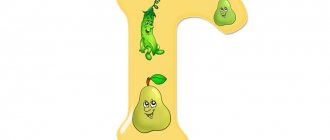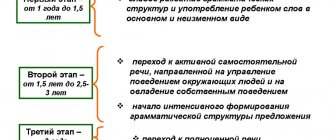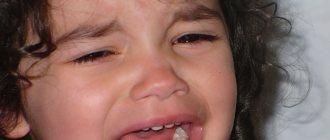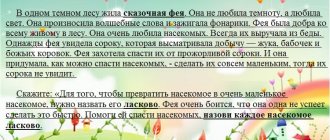Dislalia
The most common speech therapy problem for children aged 4-5 years and older. This term refers to the incorrect pronunciation of sounds, sometimes two or three sounds, and sometimes half the alphabet. You can confidently make such a conclusion about dyslalia if:
- the child’s vocabulary of passive and active vocabulary corresponds to age;
- he constructs phrases and sentences correctly;
- words are consistent in gender, number and case.
If, in addition to defective pronunciation of sounds, there are other violations, then we can talk about a general underdevelopment of speech.
What to do if a child is diagnosed with dysarthria: advice from a speech therapist
Some parents are faced with the fact that their child - natural or adopted - has speech problems and, hearing the word “dysarthria”, feel confused. What is dysarthria, why does it occur and how to correct it, says Resource specialist, speech therapist of the highest category, member of the Russian Dyslexia Association Galina Orlova.
− Dysarthria is a disorder of the pronunciation side of speech, which is associated with damage to the central part of the speech motor analyzer and a violation of the innervation of the muscles of the articulatory apparatus. Simply put, the child cannot fully perform the movements necessary for speech. Sound pronunciation suffers from this, explains Galina. - In milder cases, this is a distortion of certain sounds. In severe cases of the diagnosis, omissions and replacement of sounds may be noticed. The pace and expressiveness of speech are impaired.
Dysarthria can also be characterized by the presence of paralysis and paresis of the organs of articulation. In this case, incomprehensible speech is a consequence of the diagnosis, up to the absence of speech due to complete paralysis of the speech motor muscles - anarthria.
The causes of dysarthria can be different - deviations from the norm during intrauterine development due to toxicosis, hypertension, nephropathy in the mother, infectious diseases suffered by a woman during pregnancy, as well as asphyxia of newborns, rapid or prolonged labor, mechanical obstetrics, a long anhydrous period in childbirth
From the very first days of life, such children are observed by a neurologist. They are often prescribed medication, massage and other rehabilitation procedures.
− How to recognize dysarthria?
− An attentive parent may suspect it by the child’s unusual facial expressions, profuse salivation, the shape and position of the tongue, the ability to fix an articulatory position, and sound pronunciation.
− When should you start working with dysarthrics?
− It is advisable to begin speech therapy work with any speech disorder in early preschool age. The earlier the disease is diagnosed, treatment and corrective classes are started, the greater the chances of success.
− What should parents do if their child is diagnosed with dysarthria?
— The first step, of course, is an examination by a neurologist. There are no special medications to combat dysarthria. The doctor only corrects some neurological symptoms with the help of medications. It is also important to consult a speech therapist who knows the technique of speech therapy massage, who, after a full examination, will give a conclusion and recommendations.
In addition, experts advise developing fine motor skills. You can assemble puzzles and Lego sets, sculpt from plasticine - there are many games that develop little fingers. You can use non-traditional methods of influence, such as su-jok therapy. The simplest method of su-jok therapy is training with special massage balls.
Logorhythmics classes are recommended for children two to three years old, for example, according to Zheleznova’s method. To correct dysarthria in children five years old, a speech pathologist is involved in the classes.
− What is the focus of the speech therapist’s work in the classroom?
— The specialist is engaged in the development of the prosodic side of speech - rhythm, strength, timbre, melody, tempo, logical stress, diction, as well as articulation and sound pronunciation, auditory attention, phonemic hearing, correction of speech breathing. The speech therapist will also pay attention to the normalization of muscle tone in the articulatory muscles and the development of voluntary facial movements.
If you do not have the opportunity to visit a speech therapist, then you can work with your child at home on your own, having previously completed a course with a specialist.
I will give examples of some elements of speech therapy massage and self-massage: take turns puffing out our cheeks, retracting our cheeks; close and open your mouth, click your teeth; suck on a small piece of sugar or candy; imitate the resorption of a lollipop; lick your lips; We hold a piece of bandage or gauze with our teeth for a long time; the adult’s task is to try to carefully remove the fabric.
It is also important to perform a complex of articulatory gymnastics - these are the “Proboscis” exercises (pull your lips forward, teeth and lips are closed, hold for five seconds), “Fence” (lips in a smile are tense with the mouth slightly open, teeth are clenched, the lower jaw is in a calm state, hold for five seconds) and their alternation, “Window” (with each count we open and close our mouth), “Spatula” (when smiling with an open mouth on a relaxed lower lip, place the tongue flat, hold for five seconds), “Needle” (smile with an open with our mouth, we put our tongue forward, trying not to bend it upward), “Needle shovel” (alternating exercises), “Clock” (we smile with our mouth open, stick out our tongue and make movements to the right and left, while touching the corners of our mouth with our tongue), “ “Swing” (smile with an open mouth, the tip of the tongue resting either on the upper or lower teeth), “Horse” (we click the tip of the tongue, imitating the clatter of hooves).
Over the years of work, I have often met children diagnosed with dysarthria of varying severity. This type of speech disorder has become a global problem in recent years, so it is extremely important to identify disorders in time and consult a specialist. But parents should know that correctional work with dysarthric children should not be limited to classes with a speech therapist. For the best results, this work should be continued at home, on a walk and in any joint activities.
Press service of the Department of Labor and Social Protection of the Population of Moscow
General speech underdevelopment
This is a complex of various speech pathologies, expressed by the following characteristic features:
- undeveloped coherent speech;
- violation of pronunciation and differentiation of sounds;
- vocabulary is poor and not age appropriate;
- word formation and inflection are difficult.
With general underdevelopment of speech, all components of the system suffer: phonetics, vocabulary, grammar. Such children start speaking late. They understand the speech of others, but cannot formulate the statement themselves.
There are three levels of OHP:
- There are individual elements of speech, babbling words, one-word sentences, abbreviations of complex words.
- Speech consists of short phrases consisting of 2-3 distorted words, with syllables rearranged and inconsistent with each other.
- The use of prepositions, endings, and the syllabic structure of complex words is impaired.
The main causes of such speech therapy problems in children are the pathological course of pregnancy and birth trauma. They can also be the causes of the following speech pathology.
Speech therapy speech disorders. Speech disorders
In Russia now:
In 2021, the head of the Ministry of Education and Science, Olga Vasilyeva, spoke about the problem of increasing the number of speech pathologies. She called on the regions to increase the number of positions for school psychologists and speech therapists. According to the minister, today 58% of children have speech therapy problems. At the same time, there are 850 students per school teacher-psychologist, and 420 children in kindergartens. 2021
In the 2000s, more detailed studies were carried out in St. Petersburg by the Psychological and Pedagogical Institute. We examined 580 children of preparatory groups (children of six years old) from 44 ordinary district kindergartens according to a unified scheme (state of sound pronunciation, vocabulary, development of grammar and inflections, simple sound analysis of words).
“The results of the study showed that 52.5% of children had sound pronunciation defects, and 16.7% of this number were complete sound substitutions, indicating the non-disappearance of “age-related tongue-tiedness” and being an undoubted prerequisite for articulatory-acoustic dysgraphia. The remaining 35.8% were mainly erased and severe dysarthria.
Regarding the state of sound pronunciation, an alarming fact is that even in the younger groups of kindergartens it is no longer possible, since almost every third child has pathological forms of sound pronunciation disorders. Thus, of the 145 examined children aged 3 to 4 years, 20% had an erased form of dysarthria and 10.3% had mechanical dyslalia, which is a total of 30.3%.
Along with this, it was revealed that 21.5% of children in preparatory groups had a vocabulary that lagged behind the norm, 25% had an undeveloped inflection function (normally it should be formed by about 4 years) and 61.6% had a word formation function (in Normally, a child masters the basic methods of word formation by the beginning of school). In addition, even the simplest forms of phonemic analysis of words turned out to be inaccessible to 25% of those examined" (Speech therapy: a textbook for students. defectology. faculty. pedagogical institutions of higher education. Institutions / edited by L.S. Volkova. - 5th ed., revised and supplemented - M.: humanitarian publishing center VLADOS, 2006.)
2000. Research by Filicheva T.B.: Speech underdevelopment in preschool children - 40-50% (out of 5128 preschoolers, 948 children with ODD, 1794 children with FFND and other pathologies).
Total: 58 – 61% of all violations.
In the USA and Europe now.
2006 According to the American National Institute on Deafness and Other Communication Disorders: more than 5% of American children aged 6-7 years were diagnosed with various speech disorders, and approximately 2.5% of children under 5 years old had stuttering.
Here we should add a specific language disorder (in our country it is called motor alalia) 8 - 10% of children.
Total: 15 – 18% of all speech disorders.
Comparison with how it used to be in the USSR.
Statistics of the 50s of the 20th century in the USSR. Sound pronunciation disorders - about 17% (preschoolers and primary schoolchildren). Dysgraphia (primary schoolchildren) – 6%.
Statistics of the 2000-2010s of the Russian Federation (Moscow and the region, St. Petersburg and the region). Sound pronunciation disorders 52.5%. Dysgraphia (primary schoolchildren) – 37%.
Also from the textbook “Speech Therapy” by Volkova - with reference to Khvattsev.
Total: the number of violations increased by 3–6 times.
Statistics analysis
- “in recent decades (...) there have been profound socio-economic, environmental and other changes in our reality, which have led to a sharp increase in various types of pathologies in children and adults, including speech. (...) the situation is such that in many cases it is necessary to take the most urgent measures to level out a very difficult and complex situation.”
(Speech therapy: textbook for students. defectology. faculty. pedagogical higher education institutions / edited by L.S. Volkova. - 5th ed., revised and additional. - M.: humanities publishing center VLADOS , 2006. )
Many parents reason like this: so what if my child speaks incomprehensibly (“not enough”, “badly” - insert your own) when all the children around him say the same thing. As one mother wrote on her blog: “We get so used to living among the norm that we cease to realize that this is not the norm!”
What is the reason for the increased number of speech disorders according to ordinary speech therapists:
- salary 11 thousand rubles. per month differs from the salary in the USSR - when speech therapists received the same salary as engineers. Many good specialists have left;
- Reducing the rates of speech therapists in kindergartens, schools, and clinics;
- Reduction of kindergartens and schools of TNR;
- Appointments with speech therapists in clinics instead of 2 years at 5 years;
- Reduction of speech therapy classes in government institutions from 1 academic hour to 15 minutes;
- Increasing the number of children in the ONR speech group from 12 to 18 children (without increasing the speech therapist’s working hours). Previously, in the 30s - 50s there were only 5 people in the logo group;
- The emergence of combined (integrated) logogroups - where all speech disorders are located together;
Disorders of tempo and rhythm of speech
These speech therapy problems in children are noticeable even to non-specialists. Among them:
- Tahilalia - accelerated pronunciation of words and sentences;
- Bradylalia - slow pronunciation, accompanied by the same internal speech (such a child also thinks slowly);
- Stumbling - stops in speech of a non-convulsive nature;
- Stuttering is one of the most difficult speech pathologies to correct, caused by convulsions of all parts of the speech apparatus. The cause of stuttering is improper speech education, mental trauma.







